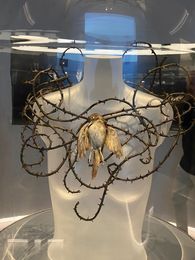If one is spending a summer in New York, any summer in New York, an absolute must-do is to spend an afternoon at the city’s Metropolitan Museum of Art, on the edge of Central Park, just gawking in gobsmacked awe at the annual fashion exhibition the museum’s Costume Institute puts together. The museum does this with a massive fundraiser under the aegis of the fashion world’s queen bee Anna Wintour, and her snobby Conde Nast stable. Wintour and the media company ensure the who’s who of international celebrities attend the gala, from Rihanna to Roger Federer.
I was lucky to catch the exhibit in its last week. The title, ‘Sleeping Beauties: Reawakening Fashion’, made no sense to me at all since its themes are usually quite specific. It is Christian art in fashion one year, Karl Lagerfeld the year he had passed, camp and queer fashion, China and oriental fashions, and such. I did not understand this year’s title until I actually saw the show.
Many of the garments shown here were indeed “sleeping”, or placed lying down as they were too delicate to be worn by a mannequin. They were placed in glass coffins, with various stages of their decay pointed out to visitors. It was almost poetic, to see such artful works age. One felt incredibly lucky to see some of the earliest pieces in fashion history up close, albeit at the nearly last stages of their life.
It was also emblematic of the world we are in today. The mannequins are usually male or female. And fashion has been at the forefront of removing gender from the world’s lexicon. When much of the young world is not choosing the gender assigned at birth, or choosing to be gender-less entirely, this new identity was driven home, too.
Now, for the second part of the title. ‘Reawakening Fashion’ is an homage to spring, fashion’s favourite season of course. But also the need to restore fashion to its former glory, not invaded by social media attention or bottomline-seeking boredom. There were flowers, birds, butterflies, snakes and seashells everywhere—even live wheatgrass growing on a woollen coat by Loewe. Designer Jonathan Anderson played with nature and artifice, and unpacked the organic idea of clothing by actually creating a coat with seeds in it, so that real grass could grow and renew itself using the jacket as turf. One could hardly escape the metaphor: fashion is organic, alive, cyclical, dies and is reborn.
Designer Mayyur Girotra has done a terrific review of this exhibition for this magazine, so I will refrain. I’ll just list out some of my favourites instead. A white organza dress, embroidered with 3-D flowers from the House of Dior, made by Christian Dior himself in 1952, looks as good as new. Another 3-D dress by Japanese label Undercover has pink roses stitched on a satin underlayer, and a white nylon tulle over it embroidered with black spiders. Alber Elbaz had made a dress for Lanvin in 2013 using beads and paillettes to mimic dragonflies, butterflies and other winged insects. Birds and insects inventively showed up on the dresses of several other designers too, such as Alexander McQueen and Madeleine Vionnet, in 1938. Fashion’s cruel nature was on display in a room filled with real birds taxidermied for necklaces and hats.
But I think the real success of the show was how insanely crowded it was; I had to queue up for nearly an hour to get into the exhibition rooms. The attending usher tells me it was like this every day since it opened.
X@namratazakaria


